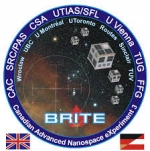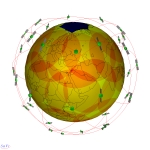Displaying items by tag: satellite constellation
Flock 1 constellation (Dove satellites)
Flock 1 is a fleet of 28 small satellites. Its deployment began on 11 Feb 2014 from the International Space Station. It was at that date the largest single constellation of Earth-imaging satellites ever to launch into space.
Built and operated by Planet Labs of San Francisco, the Flock 1 small satellites are individually referred to as Doves.
The Dove satellites are part of a class of miniature satellites often called CubeSats. These small satellites will capture imagery of Earth for use in humanitarian, environmental and commercial applications. Data collected by the Flock 1 constellation will be universally accessible to anyone who wishes to use it.
BRITE constellation
The BRITE constellation is a network of nano-satellites to investigate the properties of the brightest stars in the sky. It currently consists of a group of six nano-satellites which will participate in a common effort to study the variability of bright stars.
BRITE means BRIght-star Target Explorer.
Three countries are contributing spacecraft:
- AUSTRIA with BRITE-AUSTRIA (TUG-SAT-1) and UniBRITE satellites,
- POLAND with BRITE-PL (a.k.a 'Lem') and BRITE-PL2,
- as well as CANADA with BRITE-CA1 and BRITE-CA2.
O3b (constellation)
The O3b Satellite Constellation is a satellite constellation designed for telecommunications and data backhaul from remote locations.
This new constellation is scheduled for deployment in 2013 and will initially be made up of 8 satellites with plans to extend this to 16.
The constellation is owned and operated by O3b Networks, Ltd.
DMC International Imaging (DMCii)
DMC International Imaging (DMCii) is a company specialised in Earth imaging services. It provides: satellite imagery, archived data, related project services, and manages the DMC satellite constellation.
The company manages the Disaster Monitoring Constellation (DMC), a constellation of Earth observation satellites. It is a satellite constellation that delivers high frequency imaging anywhere on the globe from an established and growing collection of satellites. The constellation is coordinated by DMCii to deliver high quality commercial earth imaging services.
DMCii manages the DMC constellation for the 'International Charter for Space and Major Disasters'.
DMCII is a wholly owned subsidiary of Surrey Satellite Technology Ltd (SSTL).
SC Modeler
SC Modeler is a software for the conceptual design, visualization and analysis of satellite constellations.
It was written for aerospace engineers and other professionals involved in development of space-based communications systems, Earth observation systems, navigation systems.
SC Modeler provides an integrated modeling environment and all the necessary functionality for visualizing a satellite constellation and carrying out many tasks of constellation analysis including visibility studies and analysis of the geometry of communication links. The software includes a set of productivity tools which offers an efficient and convenient way of managing model properties, constellation parameters and design constraints.
company: AVM Dynamics
Globalstar (constellation)
Globalstar is a low Earth orbit (LEO) satellite constellation for satellite phone and low-speed data communications, somewhat similar to the Iridium satellite constellation and Orbcomm satellite systems.
The Globalstar project was launched in 1991 as a joint venture of Loral Corporation and Qualcomm. On March 24, 1994, the two sponsors announced formation of Globalstar LP, a limited partnership established in the U.S., with financial participation from eight other companies, including Alcatel, AirTouch, Deutsche Aerospace, Hyundai and Vodafone.
Now operated by the American company Globalstar USA, LLC.
ORBCOMM Inc.
ORBCOMM Inc. is a company that offers machine to machine (M2M) global asset monitoring and messaging services from its constellation of 29 Low-Earth-Orbit (LEO) communications satellites orbiting at 775 km.
Like its voice-centric competitors Iridium and Globalstar, it filed for Chapter 11 protection, in September, 2000. ORBCOMM issued a public offering of stock in November 2006. The company sold 9.23 million shares of common stock.
ORBCOMM provides satellite data services. ORBCOMM has control centers in the United States, Brazil, Japan, and Korea, as well as U.S. ground stations in New York, Georgia, Arizona, and Washington State, and international ground stations in Curaçao, Italy, Australia, Kazakhstan, Brazil, Argentina, Morocco, Japan, Korea, and Malaysia. Plans for additional ground station locations are under way.
ORBCOMM is offering services for users who send very small amounts of data. To avoid interference, terminals are not permitted to be active more than 1% of the time, and thus they may only execute a 450ms data burst twice every 15 minutes. The latency inherent in Orbcomm’s network design prevents it from supporting certain safety-critical applications.
Orbcomm's direct competition includes Globalstar’s simplex services and L-band leased capacity services such as those offered by SkyBitz. Orbcomm's most significant competitor, however, is Iridium, which offers the lower latency and more capable Iridium SBD service which can send larger data packets with lower latency and a much smaller antenna.
ORBCOMM services are much like email and messages.
RapidEye AG
RapidEye AG was a German geospatial information provider focused on assisting in management decision-making through services based on their own Earth observation imagery. The company owns a five satellite constellation producing 5 meter resolution imagery that was designed and implemented by MacDonald Dettwiler (MDA) of Richmond, Canada. Originally located in Munich, the company relocated 60 km southwest of Berlin to Brandenburg an der Havel in 2004.
Applications
RapidEye provides geospatial information-based management solutions to the following industries: agriculture, forestry, environment, spatial solutions.
Satellites
Five Identical Satellites: Built by Surrey Satellite Technology Ltd. (SSTL) of Guildford, subcontracted by MacDonald Dettwiler (MDA). Each satellite is based on an evolution of the flight-proven SSTL-100 bus, and measures less than one cubic meter and weighs 150 kg (bus + payload).
On November 6, 2013 RapidEye has officially changed its name to BlackBridge.
Iridium satellite constellation
The Iridium satellite constellation is a large group of satellites providing voice and data coverage to satellite phones, pagers and integrated transceivers over Earth's entire surface. The company Iridium Communications Inc. owns and operates the constellation and sells equipment and access to its services.
The constellation operates 66 active satellites in orbit to complete its constellation and additional spare satellites are kept in-orbit to serve in case of failure. Satellites are in low Earth orbit at a height of approximately 485 mi (781 km) and inclination of 86.4°. Orbital velocity of the satellites is approximately 17,000 mph (27,000 km/h). Satellites communicate with neighboring satellites via Ka band inter-satellite links. Each satellite can have four inter-satellite links: two to neighbors fore and aft in the same orbital plane, and two to satellites in neighboring planes to either side. The satellites orbit from pole to pole with an orbit of roughly 100 minutes. This design means that there is excellent satellite visibility and service coverage at the North and South poles, where there are few customers. The over-the-pole orbital design produces "seams" where satellites in counter-rotating planes next to one another are traveling in opposite directions. Cross-seam inter-satellite link hand-offs would have to happen very rapidly and cope with large Doppler shifts; therefore, Iridium supports inter-satellite links only between satellites orbiting in the same direction.
Alliant Techsystems Inc. (ATK)
Alliant Techsystems Inc., most commonly known as ATK, is one of the largest aerospace and defense companies in the United States with more than 18,000 employees in 22 states, Puerto Rico and internationally.
ATK is a pioneer in solid rocket propulsion systems, strategic missiles, missile defense, lightweight space deployables, solar arrays and satellite thermal management systems, while developing new technologies for small and micro satellites.
ATK’s human space capability includes solid rocket boosters, engineering services, astronaut tools and solar arrays. Its Reusable Solid Rocket Motors (RSRM) have been propelling the space shuttle since its beginning. In the commercial market ATK offers its Liberty Launch Vehicle, which includes a five-segment solid rocket first stage and liquid fueled upper stage to transport astronauts to the International Space Station (ISS). ATK is also developing the launch abort and attitude control motors for the Ares I Orion crew capsule, as well as the circular shape ultra-light solar arrays that will power the capsule.
Propulsion systems for strategic missiles and missile defense systems is a core capability. ATK provides all three stages for the Minuteman III and Trident II D-5 missiles. In the missile defense arena, ATK also provides all three stages for the Ground-based Missile Defense (GMD) system.
ATK’s involvement with Operationally Responsive Space (ORS) extends from launch vehicles to small and micro satellites. With ATK’s versatile product line of solid rocket motors, multiple launch vehicle configurations can be developed to support specific mission requirements.
The company’s small satellite capabilities include responsive development, constellation solutions, single-string and redundant avionics architectures. ATK also provides commercial boosters for the Delta rockets. The company is teamed with Lockheed Martin to provide the commercial Athena launch vehicle.











